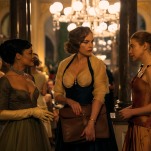This Year in PG-13 Dystopia
The stories we’re aiming at kids reflect our own fears.

Note: Readers should beware of a frank scene involving sexual harassment and also spoilers for a group of films you might end up hearing from the other room when your 13-year-old has a slumber party.

I think those of us who have kids, or are regularly trusted with the care of kids, try to get them into the stuff we’re into, and that this is sometimes harmless and fun and sometimes a bit self-serving. I remember my father sitting me down for all sorts of movies or books that were a step or two above my film literacy when I was young, purely because he hoped I would become just as obsessed with them as he was. This worked well in the case of Blade Runner (and not so well in the case of Hemingway). Some of this year’s pricey PG-13 duds seem to me to be in a different spirit: One that thinks kids can’t possibly fail to like them because they’re trying to check every box on the checklist of what people think kids are stressing about.
-

-

-

-

-

-

-

-

-

-

-

-

-

-

-

-

-

-

-

-

-

-

-

-

-

-

-

-

-

-

-

-

-

-

-

-

-

-

-

-










































